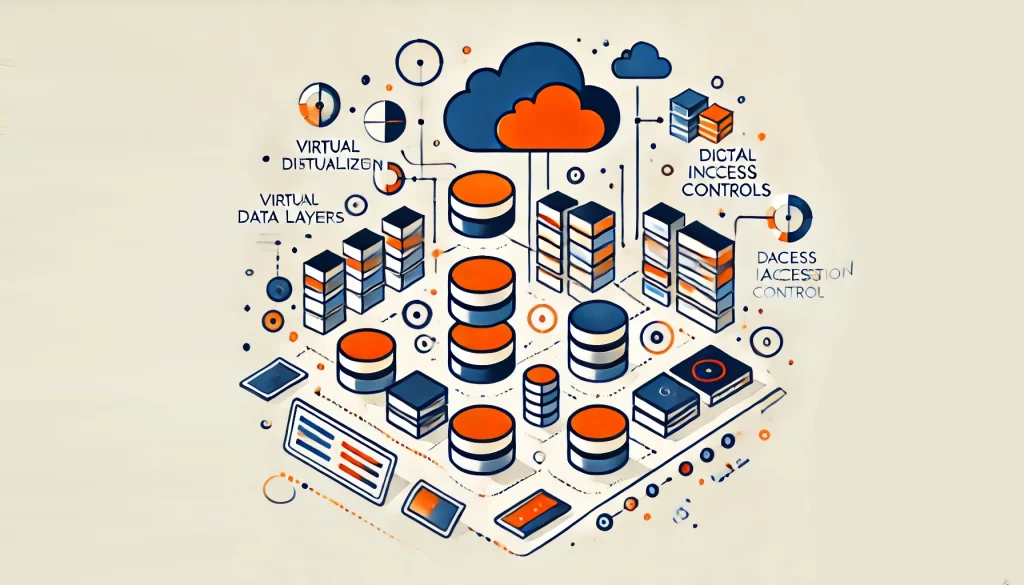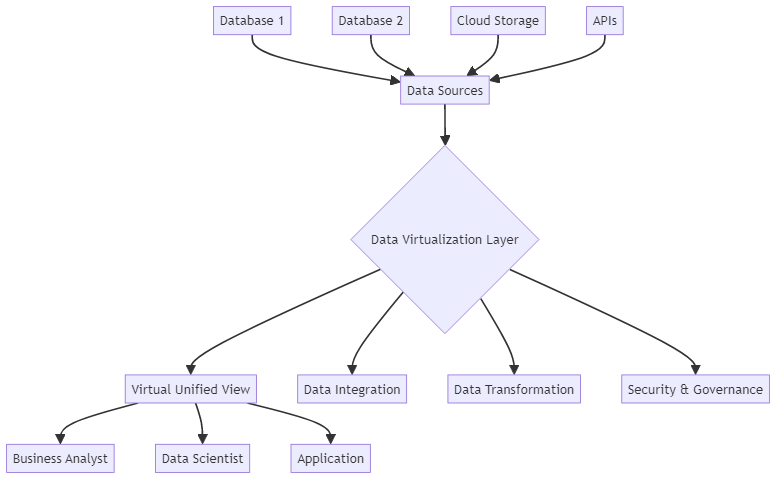
Unlocking the Power of Data Virtualization: Simplifying Data Access and Integration

Data virtualization has emerged as a powerful solution for managing and utilizing vast amounts of information across organizations. This tech lets companies use, change, and study data from different places without moving it physically. As businesses continue to generate and collect more data, the importance of efficient data management grows. Virtualization makes it easier for companies to use their data assets efficiently.
What is Data Virtualization?
Data virtualization is a technology that creates an abstract layer between data consumers and data sources. This layer lets users work with data like it’s all in one database, even if it’s in different places and formats. Virtualization makes it easier to access data by creating a virtual view. Users can interact with this view without needing to know the technical details of data storage.
Database Virtualization: A Closer Look
Database virtualization is a specific application of virtualization that focuses on creating virtual copies of entire databases. This technology lets users work with database copies in separate environments, which is great for testing, development, and analyzing. Database virtualization tools enable organizations to create lightweight, manageable copies of their databases, reducing storage costs and simplifying data management processes.
The Benefits of Data Virtualization
Data virtualization offers numerous advantages to organizations. It enhances data access, allowing users to quickly retrieve information from multiple sources without complex integration processes. This technology also improves data quality by providing a single, consistent view of information across the organization. It can save money by reducing the need for physical data storage and making data management easier.
How It Works
Virtualization platforms create a semantic layer that sits between data sources and data consumers. This layer takes user queries, converts them for each data source, gets the information, and shows it in a single format. The virtualization software handles the complexities of data integration, allowing users to focus on decision-making rather than data retrieval and formatting.

Data Virtualization vs. Database Virtualization
While virtualization and database virtualization are related concepts, they serve different purposes. It focuses on integrating data from multiple sources and presenting it as a unified view. Database virtualization, on the other hand, creates virtual copies of entire databases for testing and development purposes. Both technologies aim to simplify data management and improve efficiency, but they address different aspects of the data lifecycle.
Choosing the Right Software
Selecting the appropriate virtualization tool is crucial for success. When evaluating the solutions, consider factors such as scaling, performance, ease of use, and integration capabilities. Look for vendors that offer robust security features and support for a wide range of data sources. Some popular virtualization platforms include Denodo, TIBCO Data Virtualization, and IBM Cloud Pak for Data.
Implementing Data Virtualization in Your Organization
Implementing data virtualization requires careful planning and execution. Start by identifying your compay’s specific data management challenges and goals.
Next, assess your current data infrastructure and determine which data sources you need to integrate. Choose a virtualization platform that aligns with your requirements and develop a implementation strategy. Be sure to involve key stakeholders from IT, data management, and business units throughout the process.
Real-World Example
Consider a large retail company with multiple databases containing customer information, sales data, and inventory records. Traditionally, analyzing this data would require complex ETL processes to combine information from different sources.
With virtualization, the company can create a virtual layer that integrates all these data sources. A business analyst can see how customer details impact product sales in various areas using a virtual layer.
The software makes it easier for analysts by gathering and organizing data from different sources into one clear view. This approach saves time, reduces the risk of data inconsistency, and allows for more agile decision-making.
The Future of Data Virtualization
As companies deal with more and more data from different places, using virtualization will become more important. We will see improvements in real-time data integration. We will also see improvements in data discovery powered by machine learning.
Additionally, there will be better support for cloud and edge computing. Data virtualization vendors are making their technology faster, able to handle more data, and easier for businesses to use.
Challenges and Considerations
While data virtualization offers many benefits, it’s not without challenges. Performance can be an issue when dealing with large volumes of data or complex queries. Organizations must also carefully manage data governance and security concerns, especially when integrating sensitive information from multiple sources. Some team members may resist changes to how they manage data when using data virtualization.
Conclusion
Data virtualization represents a powerful approach to managing and utilizing data in modern organizations. This technology combines data from various sources to make it easier to access, enhance quality, and improve decision-making.
As businesses continue to generate and collect more data, the ability to quickly and effectively leverage this information becomes increasingly critical. Virtualization offers a solution to this challenge, allowing organizations to unlock the full potential of their data assets.
Whether you’re looking to streamline your data management processes, improve data access, or enhance your analytics capabilities, data virtualization is a technology worth exploring. By carefully selecting the right virtualization software and implementing it thoughtfully, organizations can gain a significant competitive advantage in our data-rich world.
